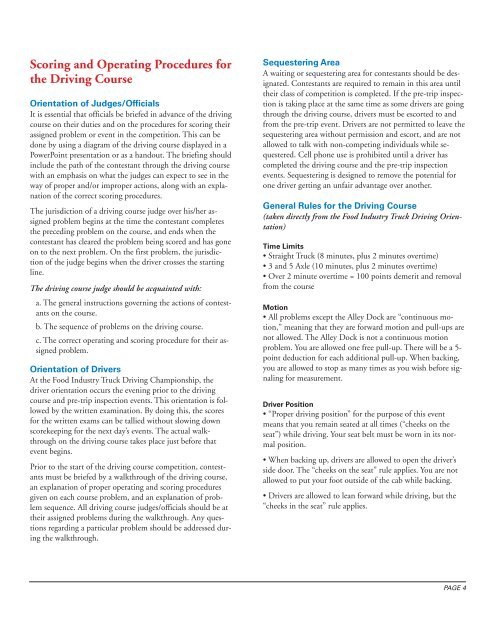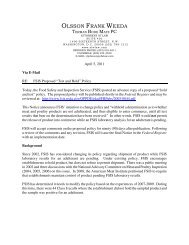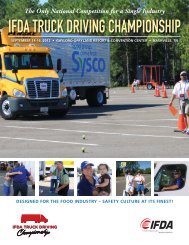Guide to Coordinating a Successful Truck Driving Competition - IFDA
Guide to Coordinating a Successful Truck Driving Competition - IFDA
Guide to Coordinating a Successful Truck Driving Competition - IFDA
Create successful ePaper yourself
Turn your PDF publications into a flip-book with our unique Google optimized e-Paper software.
Scoring and Operating Procedures for<br />
the <strong>Driving</strong> Course<br />
Orientation of Judges/Officials<br />
It is essential that officials be briefed in advance of the driving<br />
course on their duties and on the procedures for scoring their<br />
assigned problem or event in the competition. This can be<br />
done by using a diagram of the driving course displayed in a<br />
PowerPoint presentation or as a handout. The briefing should<br />
include the path of the contestant through the driving course<br />
with an emphasis on what the judges can expect <strong>to</strong> see in the<br />
way of proper and/or improper actions, along with an explanation<br />
of the correct scoring procedures.<br />
The jurisdiction of a driving course judge over his/her assigned<br />
problem begins at the time the contestant completes<br />
the preceding problem on the course, and ends when the<br />
contestant has cleared the problem being scored and has gone<br />
on <strong>to</strong> the next problem. On the first problem, the jurisdiction<br />
of the judge begins when the driver crosses the starting<br />
line.<br />
The driving course judge should be acquainted with:<br />
a. The general instructions governing the actions of contestants<br />
on the course.<br />
b. The sequence of problems on the driving course.<br />
c. The correct operating and scoring procedure for their assigned<br />
problem.<br />
Orientation of Drivers<br />
At the Food Industry <strong>Truck</strong> <strong>Driving</strong> Championship, the<br />
driver orientation occurs the evening prior <strong>to</strong> the driving<br />
course and pre-trip inspection events. This orientation is followed<br />
by the written examination. By doing this, the scores<br />
for the written exams can be tallied without slowing down<br />
scorekeeping for the next day’s events. The actual walkthrough<br />
on the driving course takes place just before that<br />
event begins.<br />
Prior <strong>to</strong> the start of the driving course competition, contestants<br />
must be briefed by a walkthrough of the driving course,<br />
an explanation of proper operating and scoring procedures<br />
given on each course problem, and an explanation of problem<br />
sequence. All driving course judges/officials should be at<br />
their assigned problems during the walkthrough. Any questions<br />
regarding a particular problem should be addressed during<br />
the walkthrough.<br />
Sequestering Area<br />
A waiting or sequestering area for contestants should be designated.<br />
Contestants are required <strong>to</strong> remain in this area until<br />
their class of competition is completed. If the pre-trip inspection<br />
is taking place at the same time as some drivers are going<br />
through the driving course, drivers must be escorted <strong>to</strong> and<br />
from the pre-trip event. Drivers are not permitted <strong>to</strong> leave the<br />
sequestering area without permission and escort, and are not<br />
allowed <strong>to</strong> talk with non-competing individuals while sequestered.<br />
Cell phone use is prohibited until a driver has<br />
completed the driving course and the pre-trip inspection<br />
events. Sequestering is designed <strong>to</strong> remove the potential for<br />
one driver getting an unfair advantage over another.<br />
General Rules for the <strong>Driving</strong> Course<br />
(taken directly from the Food Industry <strong>Truck</strong> <strong>Driving</strong> Orientation)<br />
Time Limits<br />
• Straight <strong>Truck</strong> (8 minutes, plus 2 minutes overtime)<br />
• 3 and 5 Axle (10 minutes, plus 2 minutes overtime)<br />
• Over 2 minute overtime = 100 points demerit and removal<br />
from the course<br />
Motion<br />
• All problems except the Alley Dock are “continuous motion,”<br />
meaning that they are forward motion and pull-ups are<br />
not allowed. The Alley Dock is not a continuous motion<br />
problem. You are allowed one free pull-up. There will be a 5-<br />
point deduction for each additional pull-up. When backing,<br />
you are allowed <strong>to</strong> s<strong>to</strong>p as many times as you wish before signaling<br />
for measurement.<br />
Driver Position<br />
• “Proper driving position” for the purpose of this event<br />
means that you remain seated at all times (“cheeks on the<br />
seat”) while driving. Your seat belt must be worn in its normal<br />
position.<br />
• When backing up, drivers are allowed <strong>to</strong> open the driver’s<br />
side door. The “cheeks on the seat” rule applies. You are not<br />
allowed <strong>to</strong> put your foot outside of the cab while backing.<br />
• Drivers are allowed <strong>to</strong> lean forward while driving, but the<br />
“cheeks in the seat” rule applies.<br />
PAGE 4







